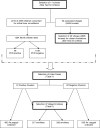Spatial and temporal clustering of dengue virus transmission in Thai villages
- PMID: 18986209
- PMCID: PMC2577695
- DOI: 10.1371/journal.pmed.0050205
Spatial and temporal clustering of dengue virus transmission in Thai villages
Abstract
Background: Transmission of dengue viruses (DENV), the leading cause of arboviral disease worldwide, is known to vary through time and space, likely owing to a combination of factors related to the human host, virus, mosquito vector, and environment. An improved understanding of variation in transmission patterns is fundamental to conducting surveillance and implementing disease prevention strategies. To test the hypothesis that DENV transmission is spatially and temporally focal, we compared geographic and temporal characteristics within Thai villages where DENV are and are not being actively transmitted.
Methods and findings: Cluster investigations were conducted within 100 m of homes where febrile index children with (positive clusters) and without (negative clusters) acute dengue lived during two seasons of peak DENV transmission. Data on human infection and mosquito infection/density were examined to precisely (1) define the spatial and temporal dimensions of DENV transmission, (2) correlate these factors with variation in DENV transmission, and (3) determine the burden of inapparent and symptomatic infections. Among 556 village children enrolled as neighbors of 12 dengue-positive and 22 dengue-negative index cases, all 27 DENV infections (4.9% of enrollees) occurred in positive clusters (p < 0.01; attributable risk [AR] = 10.4 per 100; 95% confidence interval 1-19.8 per 100]. In positive clusters, 12.4% of enrollees became infected in a 15-d period and DENV infections were aggregated centrally near homes of index cases. As only 1 of 217 pairs of serologic specimens tested in positive clusters revealed a recent DENV infection that occurred prior to cluster initiation, we attribute the observed DENV transmission subsequent to cluster investigation to recent DENV transmission activity. Of the 1,022 female adult Ae. aegypti collected, all eight (0.8%) dengue-infected mosquitoes came from houses in positive clusters; none from control clusters or schools. Distinguishing features between positive and negative clusters were greater availability of piped water in negative clusters (p < 0.01) and greater number of Ae. aegypti pupae per person in positive clusters (p = 0.04). During primarily DENV-4 transmission seasons, the ratio of inapparent to symptomatic infections was nearly 1:1 among child enrollees. Study limitations included inability to sample all children and mosquitoes within each cluster and our reliance on serologic rather than virologic evidence of interval infections in enrollees given restrictions on the frequency of blood collections in children.
Conclusions: Our data reveal the remarkably focal nature of DENV transmission within a hyperendemic rural area of Thailand. These data suggest that active school-based dengue case detection prompting local spraying could contain recent virus introductions and reduce the longitudinal risk of virus spread within rural areas. Our results should prompt future cluster studies to explore how host immune and behavioral aspects may impact DENV transmission and prevention strategies. Cluster methodology could serve as a useful research tool for investigation of other temporally and spatially clustered infectious diseases.
Conflict of interest statement
Figures




Comment in
-
A prospective study of spatial clusters gives valuable insights into dengue transmission.PLoS Med. 2008 Nov 4;5(11):e220. doi: 10.1371/journal.pmed.0050220. PLoS Med. 2008. PMID: 18998766 Free PMC article.
References
-
- Nisalak A, Endy TP, Nimmannitya S, Kalayanaryooj S, Thisyakorn U, et al. Serotype-specific dengue virus circulation and dengue disease in Bangkok, Thailand, from 1973 to 1999. Am J Trop Med Hyg. 2003;68:191–202. - PubMed
-
- Scott TW, Amerasinghe PH, Morrison AC, Lorenz LH, Clark GG, et al. Longitudinal studies of Aedes aegypti (L.) (Diperta: Culicidae) in Thailand and Puerto Rico: Blood feeding frequency. J Med Entomol. 2000;37:89–101. - PubMed
-
- Harrington LC, Edman JD, Scott TW. Why do female Aedes aegypti (Diptera: Culicidae) feed preferentially and frequently on human blood. J Med Entomol. 2001;38:411–422. - PubMed
-
- Kuno G. Review of the factors modulating dengue transmission. Epid Rev. 1995;17:321–335. - PubMed
-
- Libraty DH, Endy TP, Huong HS, Green S, Kalayanarooj S, et al. Differing influences of virus burden and immune activation on disease severity in secondary dengue-3 virus infections. J Infect Dis. 2002;185:1213–1221. - PubMed
Publication types
MeSH terms
Grants and funding
LinkOut - more resources
Full Text Sources
Other Literature Sources
Medical
Research Materials

